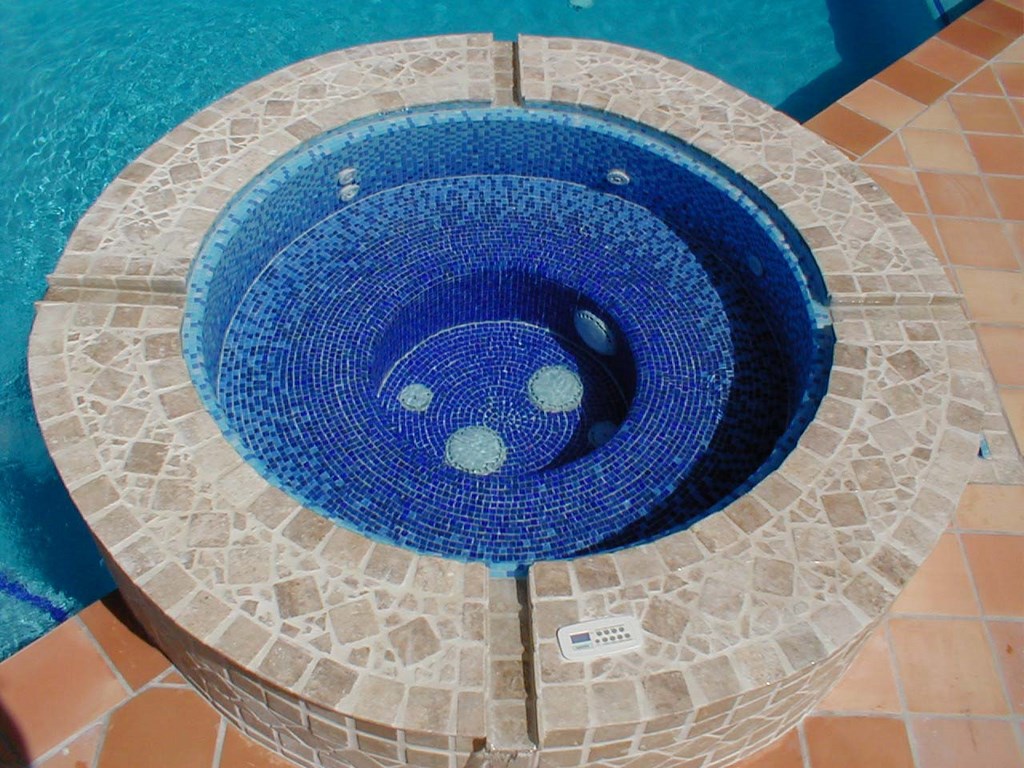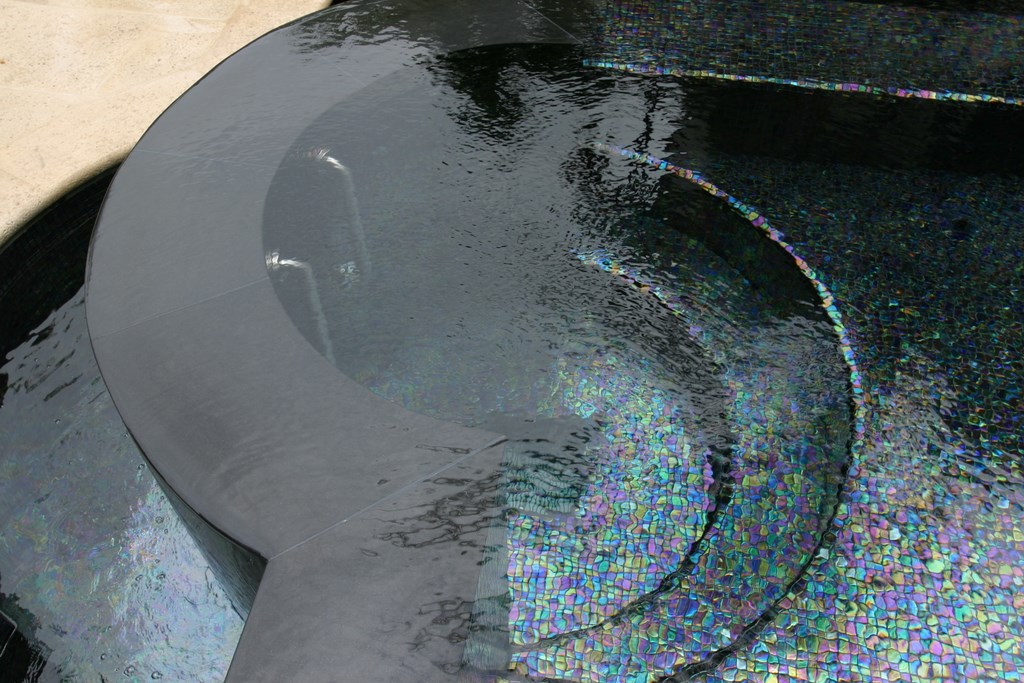Surface Value

Value is measured and determined in a variety of ways.
When it comes to pools and spas, for example, I’d say that the straight-dollar value is only one of several yardsticks and that, for many clients, it’s no longer the one that tops their lists. Instead, beauty, health benefits, artistic merit, pride of ownership and emotional appeal are more important than price tag for many of them – a wonderful trend, to my way of thinking.
These measures of value, of course, are highly subjective. Every client is a little bit different, and the relative value of non-monetary factors can be hard to define on an industry-wide basis. The best way I’ve found to understand this shift toward value-added details is to look at the materials that are now being selected for use with watershapes.
To demonstrate what I mean, let’s look at a material that is perfectly indicative of the evolutionary process taking place in the way that clients and watershapers view their projects: tile.
BEYOND CASTLES
For years, the all-tile pool has been the ultimate watershaping status symbol. Up until fairly recently, only a handful of these finishes were applied to watershape interiors by comparison to plaster and other options.
In fact, the very notion of lining an entire swimming pool with ceramic, porcelain or glass tile was so outrageous that even suggesting it was anathema to most of us in the industry. After all, when we thought back then of all-tile vessels, we’d think first and almost exclusively of the pools at Hearst Castle and jump to the conclusion that, even for our wealthiest clients, the all-tile option seemed extravagant at least and, at worst, totally decadent.
Personally, I moved past that sort of thinking a long time ago. And up until recently, I drew gasps of disbelief from other watershapers when I’d tell them how many all-tile pools I’d designed or installed. To them, the concept of selling a surface that could range from eight bucks a square foot up to $50 or more seemed downright unworkable.
Looking back, all I can say is, “How far we’ve come!” Just recently, I learned of two firms in Florida that work only with all-tile finishes. Even I was startled, after 20 years of pushing all-tile pools as my main proposition, to see these companies staking out this territory as their sole focus. It’s powerful proof that an option that was once so exclusive as to be utterly prohibitive is now being successfully purveyed as a reliable, go-to material.
This trend can be attributed in part to overall advances in watershape design and to ready capital found among upper-middle-class and wealthy homeowners. More than that, however, the ascent of appreciation for all-tile finishes indicates that the value of watershapes is no longer entirely hitched to purely financial concerns.
There are also obvious practical advantages to all-tile finishes. First, they last virtually forever when applied properly, so, unlike plaster, won’t ever require refinishing. Second, because tile is impervious to water and is smooth, it is a far friendlier surface than plaster or even pebbles when it comes to maintenance.
Certainly, those advantages haven’t changed through the years, so practicality alone cannot explain the upsurge in the use of tile as a finish. To understand fully what’s happened on the pool-surface front, we need to step back and look at a bit of history.
PLASTER AND PEBBLES
There was a time when white plaster (or Marcite, as it’s known in Florida) was the undisputed first choice among pool and spa finishes. It’s affordable and can, in its own way, be quite beautiful. For years, the only real alternative was painted concrete, which at first was also almost uniformly and unimaginatively white.
Things began to change in the early 1970s with the advent of colored plaster. All of sudden, the color palette for vessel interiors opened up, and once we started thinking in terms of color, a variety of stylistic advancements soon followed – including the naturalistic, lagoon-style pool.
The problem with plaster and painted surfaces is that, by nature, they are impermanent. To be sure, there have been real improvements in plaster technology in the form of admixtures that increase its service life and in understanding the factors that influence plaster’s durability. (Kudos to plaster and admixture manufacturers and to groups such as the National Plasterers Council for their important work.)
 For all that, however, and in the name of establishing realistic client expectations, I still have to say that plaster maintains its best appearance for five to eight years. After that, its appearance and texture will begin to change and it will eventually require replacement. Considered in the context of other surface options, it’s easy to see how the initial affordability of plaster can be offset by the fact that it will require replacement.
For all that, however, and in the name of establishing realistic client expectations, I still have to say that plaster maintains its best appearance for five to eight years. After that, its appearance and texture will begin to change and it will eventually require replacement. Considered in the context of other surface options, it’s easy to see how the initial affordability of plaster can be offset by the fact that it will require replacement.
The next great advance in pool and spa surfaces had to do with the introduction of exposed aggregates, particularly pebble finishes. These products work beautifully in everything from naturalistic, lagoon-style designs to contemporary, highly architectural designs in which the presence of the natural pebbles helps to soften the look. Clients love the appearance and texture, and it’s true that pebble finishes are much more durable than plaster alternatives.
What’s more, manufacturers of exposed-aggregate finishes have explosively expanded the color palette with countless standard and custom color mixes. Yes, these finishes cost more than plaster finishes – roughly double in most cases – but the heightened aesthetics and increased durability generally offset the expense for many homeowners.
And suppliers are continually working on these products, exploring and exploiting colored sands, polished aggregates and blends of materials that include components such as glass beads. The result is that, these days, fully two-thirds of my projects include exposed-aggregate finishes. It’s gotten to the point where I can recall installing only one plaster-finish pool in the past eight years.
BRIDGING THE GAP
Among the best outcomes of this exposed-aggregate revolution has been the fact that it has caused us to consider pool and spa surfaces in a fresh light: Where the surface was doomed to degradation, durability is now attainable. Where colors were once iffy and subject to much variation, the rainbow of available colors and textures with exposed aggregates has added incredible design flexibility and color certainty.
Perhaps most important as we return to our consideration of all-tile watershapes, the higher cost of exposed-aggregate relative to plaster finishes has essentially bridged the gap between plaster and tile and desensitized our clients to pricing. The result has been an irreversible increase in the demand for both beauty and durability on the part of the consumer, whatever the cost.
In other words, all of this evolution since the 1970s has stage for the practical emergence of all-tile finishes.

Fact is, these days there are so many spectacular tile products available that it seems to me a breach of professional responsibility to leave these finishes out of the discussion simply out of a fear to test the limits of a client’s budget. And make no mistake, even for some high-end clients, the all-tile price tag can be intimidating, especially with some of the most expensive glass-tile products.
In presenting such options to my clients, I’ve long since learned that it’s better to leave any specific discussion of cost out of the process until they’ve seen the range of available options I’ll share with them.
With tile, for instance, I typically show them a variety of samples that cover a range of colors, sizes and tile types. I’ll revisit some aesthetic goals we’ve previously established for the project, and then it’s the clients’ turn to size things up. Once they light on something they like, we talk about price – but at that point, the decision is almost always more emotional than financial.
This is partly about sales technique. More than that, however, it’s about presenting materials choices that fit within established design parameters and guiding clients not necessarily to the most expensive option, but rather to the one that works best within their vision of the design – and mine.
SATISFACTION GUARANTEED
In a great many cases, I find that clients cue immediately into the beauty of the material and quickly see how use of the right finish can transform their watershape into a true work of art. Sure, there are times when the price is out of reach and they’ll opt for something more modest – but generally the choice is among other tiles, not other finishes.
Once clients have locked in on the all-tile concept on an emotional level, the process is not unlike the one that leads to the purchase of an expensive car or a wonderful piece of furniture. In other words, there’s nothing unusual about spending large sums of money for something beautiful, and what my presentation does is place the choice of a surface material in that elevated context.
They appreciate the durability, they intuit the value of serviceability, but at the heart of the all-tile decision is a desire for something that represents their love of beautiful things. With hundreds of all-tile pools under my belt, I can honestly say that not one of my clients has ever expressed regret about the decision to go with the finest finish available – and much the same can be said for the exposed-aggregate products I’ve specified.
I can’t say the same thing about other finishes and surface materials: It’s hard to communicate the joy of the fact that someday, relatively soon, the vessel will need to be drained, the original surface removed and a new one reapplied. With all-tile watershapes, all of that anxiety is left behind.
I can’t count the number of times my clients have told me of the pride they’ve felt in showing off their pools to family and friends, or how the feel when they see the sun shimmering across the finish. Is tile for everyone? Certainly not. Furthermore, it’s not the right choice for every design. But when it’s the right call and the clients see the potential, what follows is an appreciation of the watershape as a work of art – and that, for me, is its own reward.
Brian Van Bower runs Aquatic Consultants, a design firm based in Miami, Fla., and is a co-founder of Genesis 3, A Design Group; dedicated to top-of-the-line performance in aquatic design and construction, this organization conducts schools for like-minded pool designers and builders. He can be reached at bvanbower@aol.com.










